Preferably direct porcelain news items and questions directly to Jack H. Tod,
3427 N. 47th Place, Phoenix, Ariz. 85018. All mail will be answered if reply
stamp is enclosed, and the most newsworthy items and questions of general
interest will be published as space permits.
This month's drawing in the porcelain corner (preceding page) is by Robert
Winkler and shows the J-D spiral insulators used on a test line in Gary, Indiana
from 1930 until 1943. The drawing detail is accurate to the last bolt since it
was made from a J- D photograph of the line. See article on these interesting
insulators on pages 28-30 of the October 1973 Crown Jewels.
The other day I received an Imperial Porcelain Works U-923A by mail and while
checking it with some other Imperials that I have, I found that a Sim U-925 that
has been on my shelf for 6 months has an unreported error - "PORCELIAN"
spelling' It is dated 4-18-1900 and is white.
I also have a brown U-928 which
has the second line of the incuse marking upside down.
I bought a radio
lightning arrestor with its box marked "Heineman Electric Company".
This name fits several radio insulators that I have marked "H.E.CO."
and same glaze too.
Mike Barbieri
Either one of your handstamp error markings would be rated
marking-of-the-month, so I guess you've set a record that will stand for a long
time. Errors in porcelain handstamps are so uncommon that readers might get
excited over these two new ones. This Imperial "PORCELIAN" error along
with the "PROCELAIN" error on another of their handstamps seems to
indicate some stamp maker in Trenton must have had "soem srot fo a hnagup
with seplling".
The Thomas error on the BOCK handstamp is a real Lulu, and it also indicates
this marker may have been made up from four separate type lines. By the way, I
presume you know that any of the Imperials or these early Thomas items are much
rarer in brown than they are in white.
Your attribution of the HECO marking sounds good enough for me, even though
"HECO" was also a registered tradename of the Heinze Electric Co.,
Lowell, Mass. for automotive electrical apparatus back in the 1920's. I guess
this also attributes "SENSORY" to Heineman, since it appears on some
radio antenna insulators right along with the HECO.
Just to make sure his efforts don't run us out of unattributed items to chase
down, Walt also advises he has turned up two new #334-type wiring cleats, one
marked "ROCK" and the other "C. C. E.". Both these stump me.

Dear Jack:
Enclosed are sketches of a couple of similar insulators 1-1/2" by
2-1/2" tall. Both have small pin holes with eight vertical ribs in the
hole. 'What are these?
Merle Baldwin
455 Maple Ave, Galesburg, ILL.
- - - - - - - - -
Dear Merle:
These are U.S. Army Signal Corps IN-56 insulators, first made in 1924 and
still a current item as far as I know. Yours have been altered by someone in
that the metal lag screws have been removed, and my drawing at the right shows
the whole animal.
In the original design, the lag screw was set with melted sulphur, but this
was changed to melted lead in 1940. There are a number of slightly different
design variations and including ones without the small petticoat.
All of the porcelain ones I have seen have been unmarked, but essentially
identical ones made of glass are marked IN-56, plus some glass company
scribblings
These are so commonly seen all over the U.S. that I believe they were
cataloged and sold commercially by one or more porcelain companies.
Jack
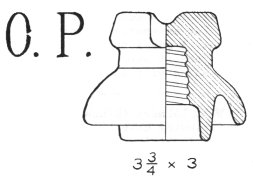
Dear Jack:
I am sending a 4 Kv porcelain insulator to you. In August 1973 issue of Crown
Jewels you said you wanted to receive informat- ion on Ohio Porcelain Co. I am
certain that this "O. P." is from that company. I also picked up a
3-petticoat, 7.2 Kv "O. P." marked with the same stamp and general
color.
I don't collect porcelain, although I keep the odd items off the line. I
haven't any idea about the number of these "O. P." items available.
John Berard
RR #1, Pierce Rd.
Port Alberni, B.C.
V9Y 7L5 Canada
- - - - - - - -

Dear John:
The "O. P. CO." marking is embossed dry press U-274 as shown here;
Ohio Porcelain made only dry press ware and not wet process as your item (strike
1). Your insulator is exactly the Canadian Porcelain Co. catalog #505 (strike
2). If you'll look closer, you'll find the marking is "C. P." and not
O.P. (strike 3). Kindly retire to the dugout and rack your bat.
This is the older version of the #505, and the newer one has a somewhat
different crown shape and a skirt with nearly vertical sides. At one time, our
General Porcelain Co. cataloged a similar item to the old #505 - possibly for
export to Canada.
Your "C. P." marking is also an older one and which I haven't seen
before. It is an over-glaze rubber stamp, and the ink run upon firing fuzzes up
the very closed C to make it appear as an O. Look at it with a magnifier, and
you can make out the actual C.
I've given your address here, as I'm certain a number of our readers are
Canadian insulator buffs and would want to get this marking for their shelf.
Jack
Carl Lencse (East Liverpool, Ohio) has found this "D & S P Co."
marking on a #334 cleat and the "D & S" on nail knobs.

This is Davidson & Stevenson Porcelain Co. of East Liverpool, founded in
1913. They had a plant across the river in Newell, W. Va. and leased another in East
Liverpool. The name changed to Davidson Porcelain Co. in 1921, and operations
were suspended in 1936. They also marked cleats "DAVIDSON" and used
the tradename "EVEREADY" on their nail knobs, together with the
marking "D. P. Co.".
The Circle-AP marking was found on solid knobs at the site of American
Porcelain Co. in East Liverpool by Carl.
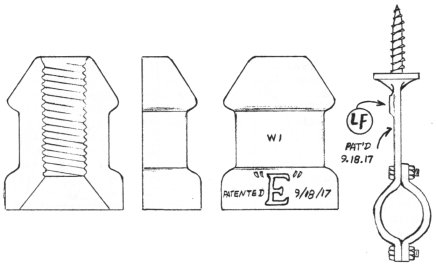
Dear Jack:
I am enclosing a very rough tracing (redrawn here) of a split clamp insulator
I recently got, complete with the metal clamp parts. It is a dark chocolate
brown not unlike the characteristic choc. brown used so much by Findlay. The E
with quote marks is interesting. Any information on the various markings?
Lew Hohn, Rochester, N.Y.
- - - - - - -
Dear Lew:
We've had a number of questions on this thing, but I don't believe we ever
ran it in the column.
This is an "L F Clamp Insulator", and they were sold by L. F.
Manufacturing Co., 426-428 Hoboken Ave., Jersey City, N.J. The company was
founded by Louis Fort, and he was sole owner. His trademark was "L F",
and the line in a broad sense was "arc lamp brackets, etc.".
The 9-18-17 patent is #1,240,330 for this type of clamp insulator system. The
"E" is the insulator size, and they also made a "D" size.
(Notes The LF line of these clamp insulators is shown on page 109 of the
Kareofelas-Cranfill "Dictionary ... ") I don't know what the Wl
marking is, but it could be a porcelain manufacturer's key.
These porcelains could have been made for Fort by one or more of the various
porcelain companies of the time, and there's no way of telling which one unless
the individual porcelain company keys appear on them.
Jack
Note: To conserve space, full addresses on reader mail are given in this
column only for those not listed in the latest Crown Jewels directory. If full
address isn't shown, look it up in directory if you wish to write them.
Rolf L. Price III, a graduate student at Washington State Univers. recently
sent to me the 4-ear insulator shown here, and this may help solve some puzzles
about other insulators as well.
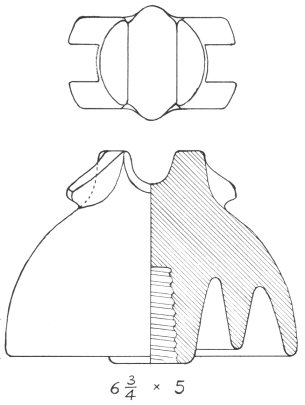
This is an Imperial, being marked 3-10-97 with the same dating stamp used by
Imperial on other items during that period, and the insulator "guts"
are essentially identical to the U-935 Imperial.
Relf said these came from an
old power line in Utah The odd arrangement of the ears would seem to indicate
they were designed for use with some type of top clamp device. This specimen
is white and is the usual fine quality which Imperial turned out.
Jack
Dear Jack:
...While I'm at it, I thought I'd pass along some information and questions I
have about my collection. At present I'm specializing in insulators used here in
the Adirondacks by the Paul Smith's Electric Light, Pover and Railroad Co. You
may not have heard of this company, for it served only Saranac Lake, Lake
Placid, Tupper Lake, and a number of smaller towns in the Adirondack woods.
What makes it good for a collector is that the company was founded before
1900 and continued with a lot of the same obsolete equipment until 1965 when it
was bought out by Niagara Mohawk Power Corp. A lot of the old insulators are
still in use where they can stand the new higher voltages, but many more have
been changed or otherwise replaced over the years and simply left along the
rights of way deep in the woods. Some places are as many as ten to fifteen miles
from any road.
Paul Smith was a guide who came to the Adirondacks around 1870. He soon found
that the popularity of the region attracted more and more visitors who came here
for the then unlimited hunting and unspoiled forests. He then built one of the
first and most famous of Adirondack hotel resorts. In order to get guests to the
hotel, he built his own 11 mile electric railroad from Paul Smith's to the new
railroad from Utica at Lake Clear Junction. This was in 1895, and the power for
the railroad came from a dam on the St. Regis River at Keeses Mills.
Smith was the first in the Adirondacks to see the growing demand for
electricity and to realize the potential for cheap hydroelectric power from the
Saranac and Raquette Rivers. In 1908 he bought land for next to nothing on the
Saranac River and built the Union Falls and Franklin Falls power stations. These
were large for the day with a capacity of about 3,000 kw each. At the same time,
he made arrangements to sell the power in the three towns and to build
transmission lines to them, a distance of some 40 miles or so. The lines were
operated at 23 Kv until 1962 when they were changed to 46 Kv. Most primary
circuits were (and still are in some cases) 2300 volts.
Smith's sons ran the company after his death in 1912 until they died in the
early 1930's. The company then became a corporation, the railroad was abandoned,
and the hotel later became the present Paul Smith's College of Arts and
Sciences, specializing in forestry and hotel management.
I understand that the railroad used wooden insulators, but so far I haven't
found any myself, nor have I seen anyone who has. As to the voltage and type of
current on which it was operated, no one seems to know either.
Now that you have the background on Paul Smith's, I have a few questions.
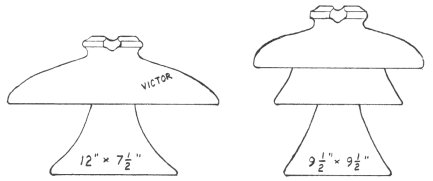
The first transmission insulators used back in 1908 were two-part cemented
ones with the incuse marking "VICTOR" on the upper surface of the top
section (left above). What makes theme unusual is their color which is a light
bluish green, some more on the blue side than others. I have never seen any like these at
shows or in catalog reprints or the like. The second transmission insulator
used (right above) was a brown 3-piecer with no name. From your description of
Pittsburg Voltage products, I believe these were made by them. Many (about half)
of these units have an incuse date (of manufacture?) on the firing surface of
the upper section. They are all in the 1912-1915 range (example "JUN 5,
1913"). Any information would be appreciated.

... I have a Locke 2-piece 45 Kv multipart insulator with the numbers 10 and
24 on each side of the insulator trademark (as shown here). I believe these
could be the insulator catalog number, or they might mean the month and year of
manufacture. They seem to fit the dating system in your book.
Thanks for the Lapp dating guide which appeared in the August 1973 issue of
Crown Jewels. With it I was able to date a U-627C to sometime in 1923. Paul
Smith's used very few Lapps.
I see people are still writing about plug fuse cutouts as in the February
column. I have a few that look brand new that came out of a transformer vault
which was installed in 1926.... I have an old Tips Tool Catalog of hot line
tools (A. B. Chance Co.) from 1931 which shows an insulated plug fuse puller
which clamped onto the knob of the cutout by turning the stick. They didn't have
to be suicide boxes. Happy collecting,
Chris Brescia, Saranac Lake, N.Y.
- - - - - - - -
Answer;
To conserve space, we usually extract the interesting parts of readers
letters, but you just can't find much to chop out of Chris' most interesting
letter. I guess if I lived in the Adirondacks, I'd sure be wearing out my pack
frame getting all those old goodies liberated from the bushes along those old
remote rights of way.
Your VICTOR multi is an old goody, and the marking was used by Locke from
about 1898 to mid-1908. For a number of years (estimated by me 1905-1915), this
pretty blue-green color was a fairly popular option in porcelain pin types and
especially on the multiparts. It is most commonly seen on Locke items similar to
yours, but was also used by Pittsburg and New Lexington (plus possibly others).
Yes, your other multi here is a Pittsburg as indicated by the full-date
marking on the crown top.
I believe the 10 -- 24 marking is the catalog number as it fits their number
block for that type of insulator. Also, this particular symbol stamp was used
from June 10, 1908 up until 1922, so this eliminates the 1924 possibility.
I still think "suicide boxes" is a fair name. That insulated plug
puller wouldn't work on the designs where the plug pushed up into the housing
and then turned 45 degrees to lock it. No way would you get me to grab that thing
before removing the hot-stick jumper from the primary first.
For all you guys who want some nice old Locke and Pittsburg items, why don't
you write to Chris.
Jack
Dear Jack:
In your Supplement B, you mentioned Ammonium Bifluoride as a porcelain
cleaner. Although you stated, "It carries a poisonous rating, and due care
should be used", you did not emphasize its toxicity. It might be a good
idea to bring this up in your column as fluorides are absorbed thru the skin and
can cause permanent injury to the bones. Mike Barbieri
- - - - - - - - -
Answer:
Correct. It's a good idea, and here is the caution notice sent with each
package of the cleaner we ever shipped out for insulator cleaning.
DANGER
Poisonous. May be fatal if swallowed. Wash thoroughly after handling and
before eating or smoking. Keep away from food.
Contains fluorine in combination. Avoid contact with eyes, nose, mouth or
skin. Keep out of reach of children.
Do not heat solution or use near any acid or acid fumes
Elsewhere in the instructions for its use in cleaning insulators are the
following excerpts:
" ... Make certain container is free of any residual acids ... Stir with
disposable stick... Use rubber gloves, tongs or a bent wire hook... " 'Nuf
said?
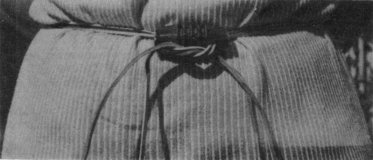
Wear your insulators! The above photo shows a nifty belt made with leather
thongs through the holes of a radio antenna strain insulator. This works neat on
glass strain as well. No comment about the model.
Jack
The 55 mph speed limit won't affect us on the way to the Hershey show. We
can't pedal faster than 30 mph anyhow.
